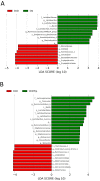Maternal Tryptophan Supplementation Protects Adult Rat Offspring against Hypertension Programmed by Maternal Chronic Kidney Disease: Implication of Tryptophan-Metabolizing Microbiome and Aryl Hydrocarbon Receptor
- PMID: 32604820
- PMCID: PMC7349830
- DOI: 10.3390/ijms21124552
Maternal Tryptophan Supplementation Protects Adult Rat Offspring against Hypertension Programmed by Maternal Chronic Kidney Disease: Implication of Tryptophan-Metabolizing Microbiome and Aryl Hydrocarbon Receptor
Abstract
Hypertension and chronic kidney disease (CKD) can originate during early-life. Tryptophan metabolites generated by different pathways have both detrimental and beneficial effects. In CKD, uremic toxins from the tryptophan-generating metabolites are endogenous ligands of the aryl hydrocarbon receptor (AHR). The interplay between AHR, nitric oxide (NO), the renin-angiotensin system (RAS), and gut microbiota is involved in the development of hypertension. We examined whether tryptophan supplementation in pregnancy can prevent hypertension and kidney disease programmed by maternal CKD in adult offspring via the aforementioned mechanisms. Sprague-Dawley (SD) female rats received regular chow or chow supplemented with 0.5% adenine for 3 weeks to induce CKD before pregnancy. Pregnant controls or CKD rats received vehicle or tryptophan 200 mg/kg per day via oral gavage during pregnancy. Male offspring were divided into four groups (n = 8/group): control, CKD, tryptophan supplementation (Trp), and CKD plus tryptophan supplementation (CKDTrp). All rats were sacrificed at the age of 12 weeks. We found maternal CKD induced hypertension in adult offspring, which tryptophan supplementation prevented. Maternal CKD-induced hypertension is related to impaired NO bioavailability and non-classical RAS axis. Maternal CKD and tryptophan supplementation differentially shaped distinct gut microbiota profile in adult offspring. The protective effect of tryptophan supplementation against maternal CKD-induced programmed hypertension is relevant to alterations to several tryptophan-metabolizing microbes and AHR signaling pathway. Our findings support interplay among tryptophan-metabolizing microbiome, AHR, NO, and the RAS in hypertension of developmental origins. Furthermore, tryptophan supplementation in pregnancy could be a potential approach to prevent hypertension programmed by maternal CKD.
Keywords: aryl hydrocarbon receptor; chronic kidney disease; developmental origins of health and disease (DOHaD); gut microbiota; hypertension; nitric oxide; pregnancy; renin–angiotensin system; tryptophan.
Conflict of interest statement
The authors declare no conflict of interest.
Figures







Similar articles
-
Maternal Adenine-Induced Chronic Kidney Disease Programs Hypertension in Adult Male Rat Offspring: Implications of Nitric Oxide and Gut Microbiome Derived Metabolites.Int J Mol Sci. 2020 Sep 30;21(19):7237. doi: 10.3390/ijms21197237. Int J Mol Sci. 2020. PMID: 33008046 Free PMC article.
-
Lactoferrin Supplementation during Pregnancy and Lactation Protects Adult Male Rat Offspring from Hypertension Induced by Maternal Adenine Diet.Nutrients. 2024 Aug 8;16(16):2607. doi: 10.3390/nu16162607. Nutrients. 2024. PMID: 39203744 Free PMC article.
-
Maternal Resveratrol Therapy Protects Male Rat Offspring against Programmed Hypertension Induced by TCDD and Dexamethasone Exposures: Is It Relevant to Aryl Hydrocarbon Receptor?Int J Mol Sci. 2018 Aug 20;19(8):2459. doi: 10.3390/ijms19082459. Int J Mol Sci. 2018. PMID: 30127255 Free PMC article.
-
Developmental Programming and Reprogramming of Hypertension and Kidney Disease: Impact of Tryptophan Metabolism.Int J Mol Sci. 2020 Nov 18;21(22):8705. doi: 10.3390/ijms21228705. Int J Mol Sci. 2020. PMID: 33218054 Free PMC article. Review.
-
Activation of aryl hydrocarbon receptor (AhR) in Alzheimer's disease: role of tryptophan metabolites generated by gut host-microbiota.J Mol Med (Berl). 2023 Mar;101(3):201-222. doi: 10.1007/s00109-023-02289-5. Epub 2023 Feb 9. J Mol Med (Berl). 2023. PMID: 36757399 Free PMC article. Review.
Cited by
-
Decoding the Complex Crossroad of Tryptophan Metabolic Pathways.Int J Mol Sci. 2022 Jan 12;23(2):787. doi: 10.3390/ijms23020787. Int J Mol Sci. 2022. PMID: 35054973 Free PMC article.
-
Developmental and lifelong dioxin exposure induces measurable changes in cardiac structure and function in adulthood.Sci Rep. 2021 May 17;11(1):10378. doi: 10.1038/s41598-021-89825-w. Sci Rep. 2021. PMID: 34001975 Free PMC article.
-
Ongoing Clinical Trials in Aging-Related Tissue Fibrosis and New Findings Related to AhR Pathways.Aging Dis. 2022 Jun 1;13(3):732-752. doi: 10.14336/AD.2021.1105. eCollection 2022 Jun. Aging Dis. 2022. PMID: 35656117 Free PMC article. Review.
-
Cardiovascular Diseases of Developmental Origins: Preventive Aspects of Gut Microbiota-Targeted Therapy.Nutrients. 2021 Jul 1;13(7):2290. doi: 10.3390/nu13072290. Nutrients. 2021. PMID: 34371800 Free PMC article. Review.
-
Hypertension of Developmental Origins: Consideration of Gut Microbiome in Animal Models.Biomedicines. 2022 Apr 9;10(4):875. doi: 10.3390/biomedicines10040875. Biomedicines. 2022. PMID: 35453625 Free PMC article. Review.
References
MeSH terms
Substances
Grants and funding
LinkOut - more resources
Full Text Sources
Medical

